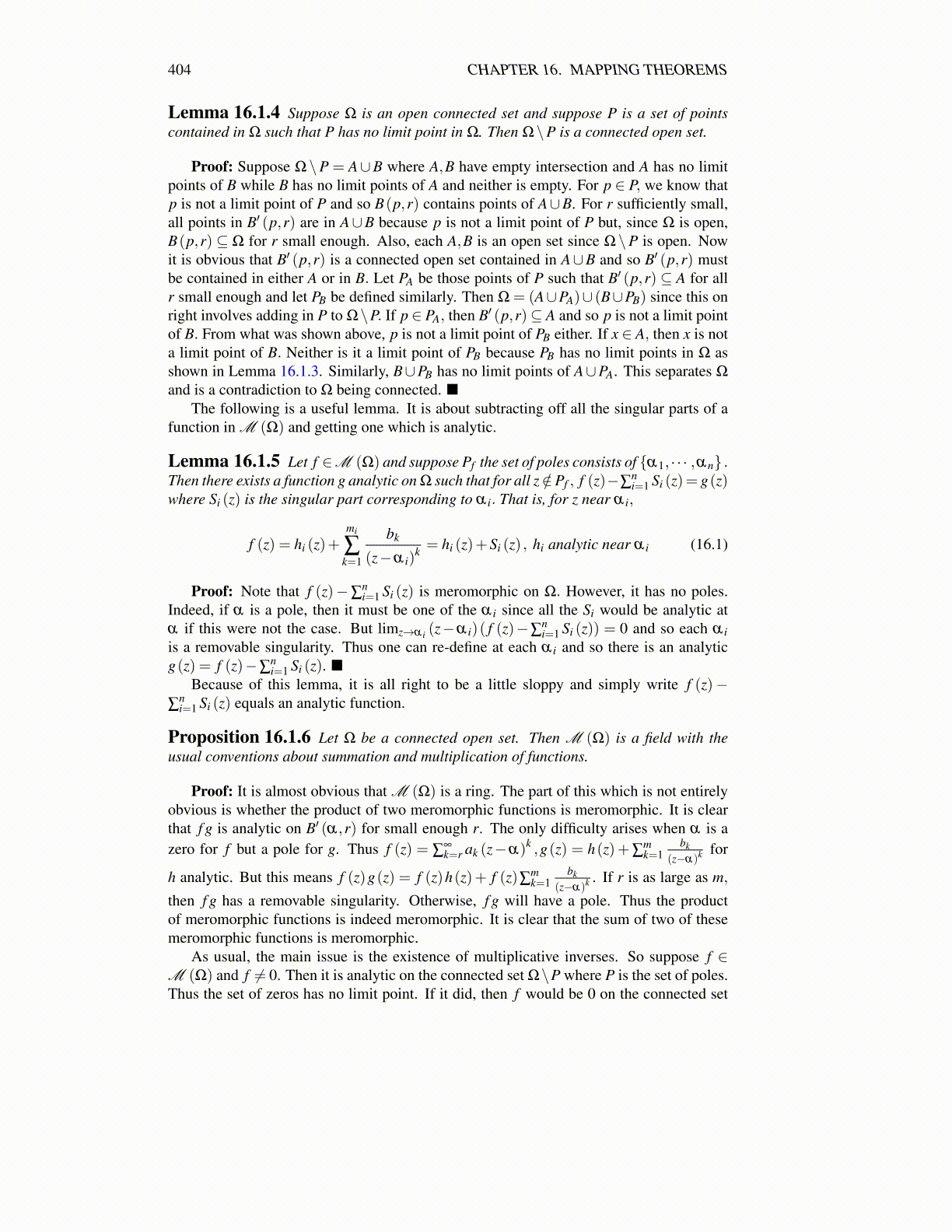
404 CHAPTER 16. MAPPING THEOREMS
Lemma 16.1.4 Suppose Ω is an open connected set and suppose P is a set of pointscontained in Ω such that P has no limit point in Ω. Then Ω\P is a connected open set.
Proof: Suppose Ω \P = A∪B where A,B have empty intersection and A has no limitpoints of B while B has no limit points of A and neither is empty. For p ∈ P, we know thatp is not a limit point of P and so B(p,r) contains points of A∪B. For r sufficiently small,all points in B′ (p,r) are in A∪B because p is not a limit point of P but, since Ω is open,B(p,r) ⊆ Ω for r small enough. Also, each A,B is an open set since Ω \P is open. Nowit is obvious that B′ (p,r) is a connected open set contained in A∪B and so B′ (p,r) mustbe contained in either A or in B. Let PA be those points of P such that B′ (p,r) ⊆ A for allr small enough and let PB be defined similarly. Then Ω = (A∪PA)∪ (B∪PB) since this onright involves adding in P to Ω\P. If p ∈ PA, then B′ (p,r)⊆ A and so p is not a limit pointof B. From what was shown above, p is not a limit point of PB either. If x ∈ A, then x is nota limit point of B. Neither is it a limit point of PB because PB has no limit points in Ω asshown in Lemma 16.1.3. Similarly, B∪PB has no limit points of A∪PA. This separates Ω
and is a contradiction to Ω being connected. ■The following is a useful lemma. It is about subtracting off all the singular parts of a
function in M (Ω) and getting one which is analytic.
Lemma 16.1.5 Let f ∈M (Ω) and suppose Pf the set of poles consists of {α1, · · · ,αn} .Then there exists a function g analytic on Ω such that for all z /∈Pf , f (z)−∑
ni=1 Si (z)= g(z)
where Si (z) is the singular part corresponding to α i. That is, for z near α i,
f (z) = hi (z)+mi
∑k=1
bk
(z−α i)k = hi (z)+Si (z) , hi analytic near α i (16.1)
Proof: Note that f (z)−∑ni=1 Si (z) is meromorphic on Ω. However, it has no poles.
Indeed, if α is a pole, then it must be one of the α i since all the Si would be analytic atα if this were not the case. But limz→α i (z−α i)( f (z)−∑
ni=1 Si (z)) = 0 and so each α i
is a removable singularity. Thus one can re-define at each α i and so there is an analyticg(z) = f (z)−∑
ni=1 Si (z). ■
Because of this lemma, it is all right to be a little sloppy and simply write f (z)−∑
ni=1 Si (z) equals an analytic function.
Proposition 16.1.6 Let Ω be a connected open set. Then M (Ω) is a field with theusual conventions about summation and multiplication of functions.
Proof: It is almost obvious that M (Ω) is a ring. The part of this which is not entirelyobvious is whether the product of two meromorphic functions is meromorphic. It is clearthat f g is analytic on B′ (α,r) for small enough r. The only difficulty arises when α is azero for f but a pole for g. Thus f (z) = ∑
∞k=r ak (z−α)k ,g(z) = h(z)+∑
mk=1
bk(z−α)k for
h analytic. But this means f (z)g(z) = f (z)h(z)+ f (z)∑mk=1
bk(z−α)k . If r is as large as m,
then f g has a removable singularity. Otherwise, f g will have a pole. Thus the productof meromorphic functions is indeed meromorphic. It is clear that the sum of two of thesemeromorphic functions is meromorphic.
As usual, the main issue is the existence of multiplicative inverses. So suppose f ∈M (Ω) and f ̸= 0. Then it is analytic on the connected set Ω\P where P is the set of poles.Thus the set of zeros has no limit point. If it did, then f would be 0 on the connected set